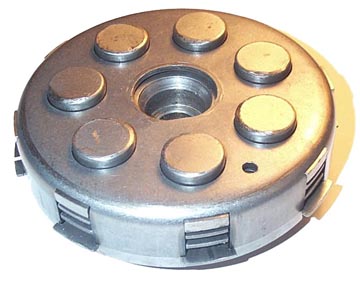 |
 |
 |
 |
 |
 |
 |
||||||||||||
Vespa Post 1979 Large Frame Engine WorkClutch Overview |
Clutch OverviewThe Vespa clutch has remained almost unchanged since the 60s. It is a basically a system of cork and steel plates running in the transmission oil, which is forced together by a series of internal springs. On large frame Vespas it connects directly to the end of the crankshaft, and on small frames it connects to the transmission input shaft.
On a large frame Vespa the clutch works like this - the crank is attached to the clutch bell which always rotates when the engine is running. Inside are three cork plates which fit into grooves within the clutch bell wall and rotate as a unit. In between each cork plate is a plain steel plate which all slot into a central drive gear only. Springs apply pressure to sandwich the steel plates and make both parts of the clutch rotate as a whole. When the clutch is disengaged the springs compress and the cork plates on the crank can rotate independently from the plain plates on the drive gear. As Vespas evolved through the years, the amounts of springs increased for more pressure on the plates to deal with the increased power from newer engines. The clutch can suffer from a multitude of problems when different parts begin to wear. The most likely cause of a slipping clutch are the cork plates themselves which are cheap to replace if you can do the work yourself. The same plates are standard replacements for all large frame Vespas since at least the GS150. Other problems may be clutch drag, slipping, and sudden lurching. |
|||||||||||||||||
